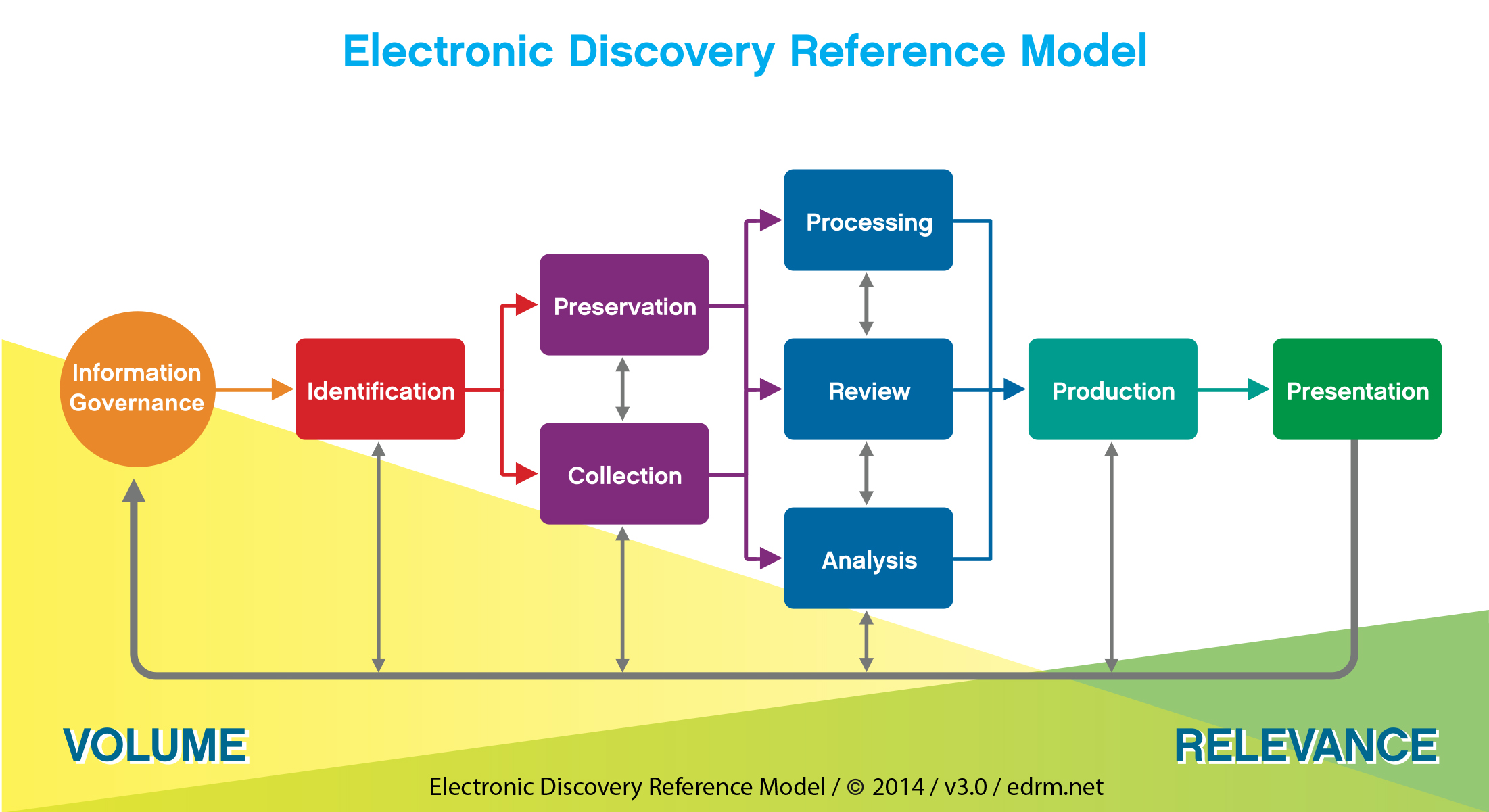
The EDRM diagram represents a conceptual view of the e-discovery process, not a literal, linear or waterfall model. One may engage in some but not all of the steps outlined in the diagram, or one may elect to carry out the steps in a different order than shown here.
The diagram also portrays an iterative process. One might repeat the same step numerous times, honing in on a more precise set of results. One might also cycle back to earlier steps, refining one’s approach as a better understanding of the data emerges or as the nature of the matter changes.
The diagram is intended as a basis for discussion and analysis, not as a prescription for the one and only right way to approach e-discovery.
Below are summary explanations of each EDRM stage. For guides for each stage of the e-discovery process, move the cursor over the boxes below for links to guides for each stage of the e-discovery process or select from the headings above the summary explanations.

Getting your electronic house in order to mitigate risk & expenses should e-discovery become an issue, from initial creation of ESI(electronically stored information) through its final disposition.
Locating potential sources of ESI & determining its scope, breadth & depth.
Ensuring that ESI is protected against inappropriate alteration or destruction.
Gathering ESI for further use in the e-discovery process (processing, review, etc.).
Reducing the volume of ESI and converting it, if necessary, to forms more suitable for review & analysis.
Evaluating ESI for relevance & privilege.
Evaluating ESI for content & context, including key patterns, topics, people & discussion.
Delivering ESI to others in appropriate forms & using appropriate delivery mechanisms.
Displaying ESI before audiences (at depositions, hearings, trials, etc.), especially in native & near-native forms, to elicit further information, validate existing facts or positions, or persuade an audience.
Zubulake v. UBS Warburg, LLC, 229 F.R.D. 422, 431 (S.D.N.Y. 2004) (Court Opinion)
During 2003 and 2004, United States District Court Judge Shira A. Scheindlin issued five groundbreaking opinions in the case of Zubulake v UBS Warburg. Zubulake is generally considered the first definitive case in the United States on a wide range of electronic discovery issues. These issues include:
Source: Kroll Ontrack (READ MORE)
Lester v. Allied Concrete Co., Nos. CL.08-150, CL09-223 (Va. Cir. Ct. Sept. 1, 2011) (Court Opinion)
Collection options
Considerations
Click here for the American Bar Association's guide on the collection of social media content for electronic discovery
D.O.H. v. Lake Cent. Sch. Corp., No. 2:11–cv–430, 2015 WL 736419 (N.D. Ind. Feb. 20, 2015).
Largent v. Reed, 2011 WL 5632688 (Pa. Ct. Com. Pl. Nov. 8, 2011).
Tompkins v. Detroit Metro. Airport, 278 F.R.D. 387 (E.D. Mich. 2012).
Thompson v. Autoliv ASP, Inc., No. 2:09-cv-01375-PMP-VCF (D. Nev. June 20, 2012).
Access: In Camera? Yes, for privilege:
In re Milo’s Kitchen Dog Treats Consol., Cases, No. 12-1011, ---F.R.D.---, 2015 WL 1650963 (W.D. Pa. Apr. 14, 2015).
Tompkins v. Detroit Metro. Airport, 278 F.R.D. 387 (E.D. Mich. 2012)
Access: In Camera? Yes, for relevance:
Douglas v. Riverwalk Grill, LLC, No. 11-15230, 2012 U.S. Dist. LEXIS 120538 (E.D. Mich. Aug. 24, 2012)
*EDRM (edrm.net). The content posted above is from EDRM.net is licensed under a Creative Commons Attribution 3.0 Unported License. That means users are free to share, remix or make commercial use of the content so long as they provide attribution. EDRM (edrm.net).
** When searching for cases regarding Electronic Discovery, K&L Gates Electronic Discovery Law website is an excellent resource. K&L Gates Electronic Discovery Law, http://www.ecliscoverylaw.com/ (last visited 8/4/16). The site contains more than 3000 cases collected from state and federal courts involving electronic discovery issues by keyword, or by any combination of 36 different case attributes. (Id.). The database is free of charge and its cases often include short summaries that include the case citation, the nature of the case, the electronic data involved, the electronic discovery issue and searchable attributes. A number of the cases have more robust summaries that also may have links to additional materials. K&L Gates and has provided Victor Bermudez with express permission to publish their information on this pathfinder.
No Legal Advice Provided
The material on our research guide’s website is intended to provide only general information and comment to our clients and the public. This research guide is created for educational purposes only. Although we make our best efforts to ensure that the information found on our website is accurate and timely, we cannot, and do not, guarantee that the information is either. Nor do we guarantee the accuracy of any information contained on websites to which our website provides links.
Do not, under any circumstances, rely on information found on our website as legal advice. Legal matters are often complicated. The law changes frequently and varies from jurisdiction to jurisdiction. Being general in nature, the information and materials provided may not apply to any specific factual and/or legal set of circumstances. For assistance with your specific legal problem or inquiry please contact a knowledgeable lawyer, who practices in your area of need and would be pleased to determine whether she or he can assist you. The State Bar Association is ordinarily a good source for referrals for competent attorneys.
No Lawyer-Client Relationship Created
This guide does not create in any way, shape or form an attorney-client relationship. Once again, no attorney-client relationship is formed nor should any such relationship be implied. In addition, any information sent by email through the internet is not confidential and does not create a lawyer-client, advisory, or fiduciary, relationship.
